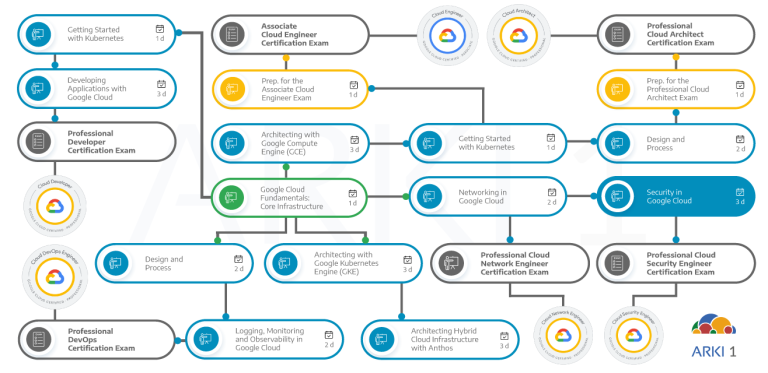Este curso de 3 dias oferece aos participantes amplo estudo dos controles e técnicas de segurança no Google Cloud Platform. Por meio de palestras, demonstrações e laboratórios práticos, os participantes exploram e implantam os componentes de uma solução GCP segura.
Os participantes também aprendem técnicas de mitigação de ataques em muitos pontos de uma infraestrutura baseada em GCP, incluindo ataques de negação de serviço distribuído, ataques de phishing e ameaças que envolvem classificação e uso de conteúdo.
Público-Alvo
Este treinamento destina-se ao seguinte público:
- [Cloud] information security analysts, architects, and engineers
- Information security/cybersecurity specialists
- Cloud infrastructure architects
Além disso, o curso é destinado também a pessoal de campo de parceiros que trabalham com clientes nessas funções.
O curso também deve ser útil para desenvolvedores de aplicativos em nuvem.
Pré-requisitos
Para aproveitar ao máximo este curso, os participantes precisam atender aos seguintes critérios:
- Conclusão do Google Cloud Fundamentals: Core Infrastructure ou experiência equivalente.
- Experiência prática de Node.js
- Proficiência básica das ferramentas de linha de comando e de ambientes de sistema operacional Linux.
- Experiência em operações de sistemas, incluindo implantação e gerenciamento de aplicativos, no local ou em um ambiente de nuvem pública.
Duração
24 horas (3 dias)
Investimento
Consulte o valor atualizado e próximas datas para turmas abertas em nossa página de inscrições. Caso tenha interesse em uma turma fechada para sua empresa, entre em contato conosco.
Resumo do curso
O curso inclui apresentações, demonstrações e laboratórios práticos.
- Understand the GCP shared security responsibility model
- Understand Google Cloud’s approach to security
- Understand the kinds of threats mitigated by Google and by GCP
- Define and Understand Access Transparency and Access Approval(beta)
- Cloud Identity
- Syncing with Microsoft Active Directory using Google Cloud Directory Sync
- Using Managed Service for Microsoft Active Directory (beta)
- Choosing between Google authentication and SAML-based SSO
- Best practices, including DNS configuration, super admin accounts
- Lab: Defining Users with Cloud Identity Console
- GCP Resource Manager: projects, folders, and organizations
- GCP IAM roles, including custom roles
- GCP IAM policies, including organization policies
- GCP IAM Labels
- GCP IAM Recommender
- GCP IAM Troubleshooter
- GCP IAM Audit Logs
- Best practices, including separation of duties and least privilege, the use of Google groups in policies, and avoiding the use of primitive roles
- Labs: Configuring Cloud IAM, including custom roles and organization
policies
- Configuring VPC firewalls (both ingress and egress rules)
- Load balancing and SSL policies
- Private Google API access
- SSL proxy use
- Best practices for VPC networks, including peering and shared VPC use, correct use of subnetworks
- Best security practices for VPNs
- Security considerations for interconnect and peering options
- Available security products from partners
- Defining a service perimeter, including perimeter bridges
- Setting up private connectivity to Google APIs and services
- Lab: Configuring VPC firewalls
- Compute Engine service accounts, default and customer-defined
- IAM roles for VMs
- API scopes for VMs
- Managing SSH keys for Linux VMs
- Managing RDP logins for Windows VMs
- Organization policy controls: trusted images, public IP address, disabling serial port
- Encrypting VM images with customer-managed encryption keys and with customer-supplied encryption keys
- Finding and remediating public access to VMs
- Best practices, including using hardened custom images, custom service accounts (not the default service account), tailored API scopes, and the use of application default credentials instead of user-managed keys
- Lab: Configuring, using, and auditing VM service accounts and scopes
- Encrypting VM disks with customer-supplied encryption keys
- Lab: Encrypting disks with customer-supplied encryption keys
- Using Shielded VMs to maintain the integrity of virtual machines
- Cloud Storage and IAM permissions
- Cloud Storage and ACLs
- Auditing cloud data, including finding and remediating publicly accessible data
- Signed Cloud Storage URLs
- Signed policy documents
- Encrypting Cloud Storage objects with customer-managed encryption keys and with customer-supplied encryption keys
- Best practices, including deleting archived versions of objects after key rotation
- Lab: Using customer-supplied encryption keys with Cloud Storage
- Lab: Using customer-managed encryption keys with Cloud Storage and Cloud KMS
- BigQuery authorized views
- BigQuery IAM roles
- Best practices, including preferring IAM permissions over ACLs
- Lab: Creating a BigQuery authorized view
- Types of application security vulnerabilities
- DoS protections in App Engine and Cloud Functions
- Cloud Security Scanner
- Lab: Using Cloud Security Scanner to find vulnerabilities in an App Engine application
- Identity Aware Proxy
- Lab: Configuring Identity Aware Proxy to protect a project
- Authorization
- Securing Workloads
- Securing Clusters
- Logging and Monitoring
- How DDoS attacks work
- Mitigations: GCLB, Cloud CDN, autoscaling, VPC ingress and egress firewalls, Cloud Armor (including its rules language)
- Types of complementary partner products
- Lab: Configuring GCLB, CDN, traffic blacklisting with Cloud Armor
- Threat: Ransomware
- Mitigations: Backups, IAM, Data Loss Prevention API
- Threats: Data misuse, privacy violations, sensitive/restricted/unacceptable content
- Threat: Identity and Oauth phishing
- Mitigations: Classifying content using Cloud ML APIs; scanning and redacting data using Data Loss Prevention API
- Lab: Redacting Sensitive Data with Data Loss Prevention API
- Security Command Center
- Stackdriver monitoring and logging
- Lab: Installing Stackdriver agents
- Lab: Configuring and using Stackdriver monitoring and logging
- VPC flow logs
- Lab: Viewing and using VPC flow logs in Stackdriver
- Cloud audit logging
- Lab: Configuring and viewing audit logs in Stackdriver
- Deploying and Using Forseti
- Lab: Inventorying a Deployment with Forseti Inventory (demo)
- Lab: Scanning a Deployment with Forseti Scanner (demo)


